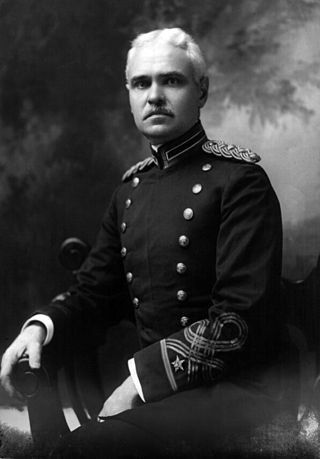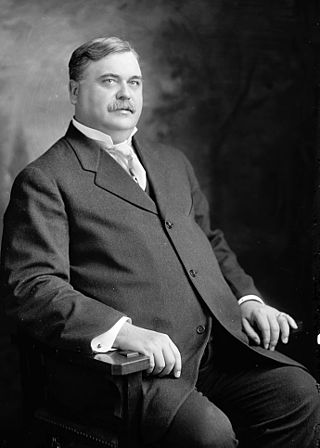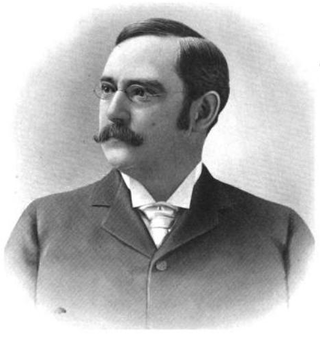Related Research Articles

The Panama Canal is an artificial 82-kilometer (51-mile) waterway in Panama that connects the Caribbean Sea with the Pacific Ocean. It cuts across the narrowest point of the Isthmus of Panama, and is a conduit for maritime trade between the Atlantic and Pacific Oceans. Locks at each end lift ships up to Gatun Lake, an artificial fresh water lake 26 meters (85 ft) above sea level, created by damming the Chagres River and Lake Alajuela to reduce the amount of excavation work required for the canal. Locks then lower the ships at the other end. An average of 200 ML (52,000,000 US gal) of fresh water is used in a single passing of a ship. The canal is threatened by low water levels during droughts.

Big stick ideology, big stick diplomacy, big stick philosophy, or big stick policy was a political approach used by the 26th president of the United States, Theodore Roosevelt. The terms are derived from an aphorism which Roosevelt often said: "speak softly and carry a big stick; you will go far". The American press during his time, as well as many modern historians today, used the term "big stick" to describe the foreign policy positions during his administration. Roosevelt described his style of foreign policy as "the exercise of intelligent forethought and of decisive action sufficiently far in advance of any likely crisis". As practiced by Roosevelt, big stick diplomacy had five components. First, it was essential to possess serious military capability that would force the adversary to pay close attention. At the time that meant a world-class navy; Roosevelt never had a large army at his disposal. The other qualities were to act justly toward other nations, never to bluff, to strike only when prepared to strike hard, and to be willing to allow the adversary to save face in defeat.

George Washington Goethals was an American military officer and civil engineer, best known for his administration and supervision of the construction and the opening of the Panama Canal. He was the first Governor of Panama Canal Zone from 1914 to 1917, and was also the State Engineer of New Jersey and the Acting Quartermaster General of the United States Army.

The Panama Canal Zone, also simply known as the Canal Zone, was a concession of the United States located in the Isthmus of Panama that existed from 1903 to 1979. It consisted of the Panama Canal and an area generally extending five miles (8 km) on each side of the centerline, but excluding Panama City and Colón. Its capital was Balboa.

John Frank Stevens was an American civil engineer who built the Great Northern Railway in the United States and was chief engineer on the Panama Canal between 1905 and 1907. He also led the commission of American railway experts to Russia and was later President of the Interallied Technical Board.
One of the greatest challenges facing the builders of the Panama Canal was dealing with the tropical diseases rife in the area. The health measures taken during the construction contributed greatly to the success of the canal's construction. These included general health care, the provision of an extensive health infrastructure, and a major program to eradicate disease-carrying mosquitoes from the area.
The Gatun Dam is an earthen dam across the Chagres River in Panama, near the town of Gatun. The dam, constructed between 1907 and 1913, is a crucial element of the Panama Canal; it impounds the artificial Gatun Lake, which carries ships 33 kilometres (21 mi) of their transit across the Isthmus of Panama. In addition, a hydro-electric generating station at the dam generates electricity which is used to operate the locks and other equipment in the canal.

Charles Edward Magoon was an American lawyer, judge, diplomat, and administrator who is best remembered as a governor of the Panama Canal Zone; he also served as Minister to Panama at the same time. He was Provisional Governor of Cuba during the American occupation of Cuba from 1906 to 1909.

The idea of the Panama Canal dates back to 1513, when the Spanish conquistador Vasco Núñez de Balboa first crossed the Isthmus of Panama. European powers soon noticed the possibility to dig a water passage between the Atlantic and Pacific Oceans across this narrow land bridge between North and South America. A number of proposals for a ship canal across Central America were made between the sixteenth and nineteenth centuries, with the chief rival to Panama being a canal through Nicaragua.

The presidency of Theodore Roosevelt started on September 14, 1901, when Theodore Roosevelt became the 26th president of the United States upon the assassination of President William McKinley, and ended on March 4, 1909. Roosevelt had been the vice president for only 194 days when he succeeded to the presidency. A Republican, he ran for and won by a landslide a four-year term in 1904. He was succeeded by his protégé and chosen successor, William Howard Taft.

George Shattuck Morison was an American engineer. A classics major at Harvard who trained to be a lawyer, he instead became a civil engineer and leading bridge designer in North America during the late 19th century. During his lifetime, bridge design evolved from using 'empirical “rules of thumb” to the use of mathematical analysis techniques'. Some of Morison's projects included several large Missouri River bridges as well as the great cantilever railroad bridge at Memphis, Tennessee, and the Boone, Iowa viaduct. Morison served as president of the American Society of Civil Engineers (1895) as well as a member of the British Institute of Civil Engineers winning that institution's Telford Medal in 1892 for his work on the Memphis bridge. In 1899, he was appointed to the Isthmian Canal Commission and recommended it be built at Panama.

Henry Larcom Abbot was a military engineer and career officer in the United States Army. He served in the Union Army during the American Civil War and was appointed brevet brigadier general of volunteers for his contributions in engineering and artillery. In 1866 he received additional brevet appointments as major general of volunteers and brigadier general in the Regular Army. He conducted several scientific studies of the Mississippi River with captain, later Major General Andrew A. Humphreys. After his retirement, Abbot served as a consultant for the locks on the Panama Canal. He was elected a Fellow of the American Academy of Arts and Sciences in 1863.

John Findley Wallace was an American engineer and administrator, best known for serving as chief engineer for construction of the Panama Canal between 1904 and 1905. He had previously gained experience in railroad construction in the American Midwest.

Joseph Bucklin Bishop, was an American newspaper editor (1870–1905), Secretary of the Isthmian Canal Commission in Washington, D.C., and Panama (1905–1914), and authorized biographer and close friend of President Theodore Roosevelt. Bishop was the author of 13 books and dozens of magazine articles, and he edited the 1920 best-seller, Theodore Roosevelt’s Letters to His Children.

Ernest “Red” Hallen (1875–1947) was an American photographer, noted for his 30 years of work as the official photographer of the Panama Canal.

The Panama Canal Department was a department of the United States Army, responsible for the defense of the Panama Canal Zone between 1917 and 1947.

The history of U.S. foreign policy from 1897 to 1913 concerns the foreign policy of the United States during the Presidency of William McKinley, Presidency of Theodore Roosevelt, and Presidency of William Howard Taft. This period followed History of U.S. foreign policy, 1861–1897 and began with the inauguration of McKinley in 1897. It ends with Woodrow Wilson in 1913, and the 1914 outbreak of World War I, which marked the start of new era in U.S. foreign policy.

The foreign policy of the Theodore Roosevelt administration covers American foreign policy from 1901 to 1909, with attention to the main diplomatic and military issues, as well as topics such as immigration restriction and trade policy. For the administration as a whole see Presidency of Theodore Roosevelt. In foreign policy, he focused on Central America where he began construction of the Panama Canal. He modernized the U.S. Army and expanded the Navy. He sent the Great White Fleet on a world tour to project American naval power. Roosevelt was determined to continue the expansion of U.S. influence begun under President William McKinley (1897–1901). Roosevelt presided over a rapprochement with the Great Britain. He promulgated the Roosevelt Corollary, which held that the United States would intervene in the finances of unstable Caribbean and Central American countries in order to forestall direct European intervention. Partly as a result of the Roosevelt Corollary, the United States would engage in a series of interventions in Latin America, known as the Banana Wars. After Colombia rejected a treaty granting the U.S. a lease across the isthmus of Panama, Roosevelt supported the secession of Panama. He subsequently signed a treaty with Panama which established the Panama Canal Zone. The Panama Canal was completed in 1914, greatly reducing transport time between the Atlantic Ocean and the Pacific Ocean. Roosevelt's well-publicized actions were widely applauded.

Naval Base Panama Canal Zone refers to a number of United States Navy bases used during World War II to both protect the Panama Canal and the key shipping lanes around the Panama Canal Zone. Bases were built and operated on the Atlantic Ocean side and the Pacific Ocean side. The main Naval Base at the Panama Canal was the Naval Station Coco Solo that had been in operation since 1918.
References
- ↑ Parker, Matthew (2008). Hell's Gorge: The Battle to Build the Panama Canal (1st ed.). Arrow. p. 214.
- ↑ "The Chief Engineers of the Panama Canal". The American Experience. WGBH-TV . PBS. Archived from the original on 31 December 2016. Retrieved 7 January 2012.
- ↑ "Obituary 4 -- No Title". The New York Times. September 23, 1919.
- ↑ My Dear Bishop, p. 222
- ↑ Hobson, Sarah, ed. (December 1918). "Biographical Summary, Robert E. Noble". Journal of the American Institute of Homœopathy. Chicago, IL: American Institute of Homeopathy. p. 591 – via Google Books.
- ↑ "UF Digital Collections". ufdc.ufl.edu. Retrieved January 21, 2025.